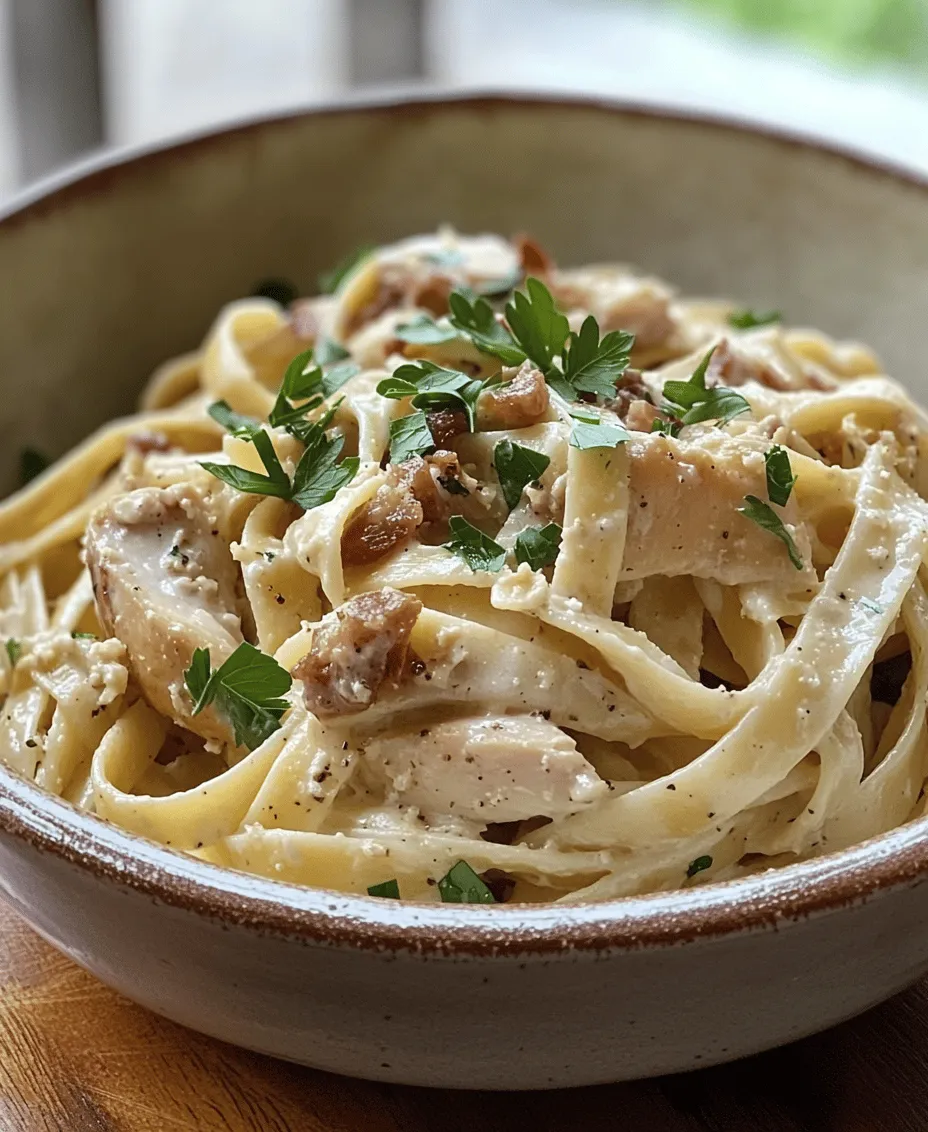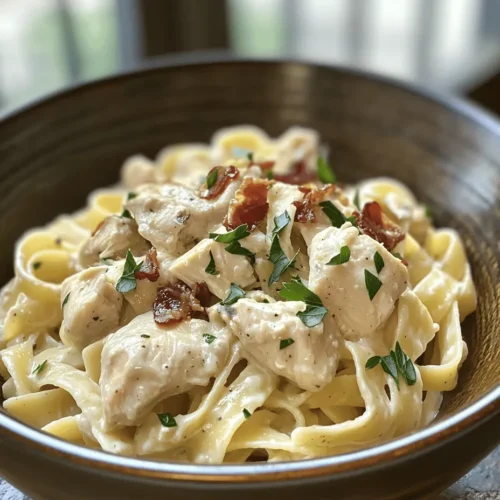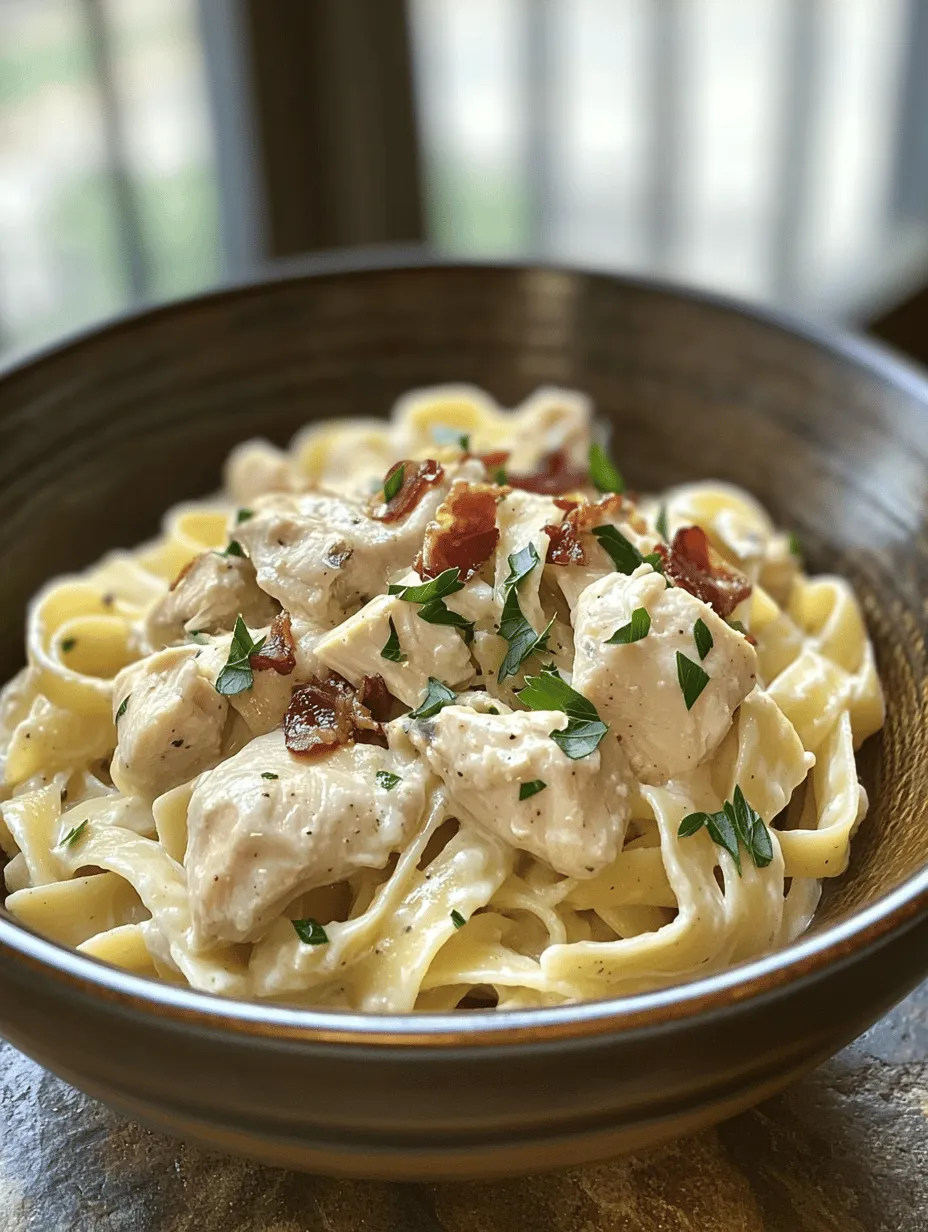Introduction
Chicken Carbonara is a delightful twist on the classic Italian dish that has captured the hearts and stomachs of food lovers around the globe. Originating from the Lazio region of Italy, traditional Carbonara is known for its rich, creamy sauce, made with eggs and cheese, tossed with pasta and accented by the savory flavors of cured pork. This dish has earned its reputation as comfort food, often synonymous with hearty meals that warm the soul and evoke the feeling of home-cooked goodness.
In recent years, the popularity of Chicken Carbonara has soared, as many home cooks seek ways to incorporate lean protein into their meals without sacrificing flavor. By adding tender, juicy chicken to the mix, this variation not only enhances the dish’s nutritional profile but also adds a new dimension of taste and texture. Whether you’re looking to impress guests at a dinner party or simply want to indulge in a comforting weeknight meal, the Best-Ever Chicken Carbonara will quickly become a staple in your cooking repertoire.
Understanding the Ingredients
To achieve the perfect Chicken Carbonara, understanding the role of each ingredient is essential. The combination of pasta, chicken, pancetta or bacon, eggs, cream, cheese, garlic, and fresh herbs creates a dish that is not only delicious but also satisfying. Let’s break down the key components that make this recipe a standout.
The Role of Pasta in Carbonara
Pasta is the foundation of any Carbonara, providing the necessary vehicle for the creamy sauce to cling to. While traditional recipes often call for spaghetti, fettuccine is an excellent alternative that can elevate this dish. The broader surface area of fettuccine allows for more sauce to adhere, resulting in a creamy bite with every forkful.
Regardless of the type of pasta used, achieving the perfect al dente texture is crucial. Cooking the pasta until it is just firm to the bite ensures that it holds up well against the rich sauce and prevents a mushy consistency. To achieve this, be sure to follow the cooking instructions on the package and taste the pasta a minute or two before the suggested cooking time is up.
Chicken: A Protein Powerhouse
Adding boneless, skinless chicken breasts to your Carbonara not only enhances its nutritional value but also infuses the dish with a delightful flavor. Chicken breasts are a lean source of protein, making them a great choice for those looking to maintain a balanced diet. When cooked properly, chicken becomes tender and juicy, adding a satisfying richness to the dish that complements the creamy sauce.
To prepare the chicken, it is advisable to season it with salt and pepper before cooking. This simple step enhances its natural flavor and allows it to shine in the final dish. Additionally, cutting the chicken into bite-sized pieces ensures even cooking and makes it easy to incorporate into the pasta.
The Savory Touch of Pancetta or Bacon
The smoky and savory notes of pancetta or bacon are what give Chicken Carbonara its signature flavor. While pancetta is an Italian cured meat with a rich, buttery taste, bacon brings a more pronounced smokiness that can also enhance the dish. Both options work well, but opting for pancetta will give you a more authentic Italian flair.
When preparing your Carbonara, it is essential to render the fat from the pancetta or bacon until it is crispy. This step not only adds texture but also releases flavorful oils that will coat the pasta and chicken, elevating the overall taste of the dish.
The Creamy Base: Eggs and Heavy Cream
A hallmark of Carbonara is its luscious sauce, which is traditionally made from eggs and cheese. In this recipe, we incorporate heavy cream to achieve a rich and creamy consistency that envelops the pasta and chicken beautifully. Fresh eggs are key to ensuring a velvety sauce; they provide the necessary thickness and richness when combined with the heat of the pasta.
To prepare the sauce, whisk the eggs together with heavy cream and freshly grated Pecorino Romano cheese. The warmth of the pasta will gently cook the eggs, creating a creamy coating that clings to each strand of fettuccine or spaghetti. Be sure to mix the sauce quickly with the hot pasta to prevent scrambling the eggs.
The Signature Flavor of Pecorino Romano Cheese
Pecorino Romano cheese is a staple in Italian cuisine and an essential ingredient in traditional Carbonara. This hard, salty cheese made from sheep’s milk imparts a sharp, tangy flavor that perfectly balances the richness of the sauce. While Parmesan can be used in a pinch, Pecorino Romano is preferred for its authenticity and depth of flavor.
When grating the cheese, opt for a microplane or fine grater to achieve a light, fluffy texture that will melt seamlessly into the sauce. The cheese not only enhances the taste but also contributes to the overall creaminess of the dish.
The Aromatic Touch: Garlic and Black Pepper
Garlic and black pepper are two aromatic ingredients that elevate the flavor profile of Chicken Carbonara. The subtle sweetness of sautéed garlic adds depth to the dish, while freshly cracked black pepper brings a gentle heat that awakens the palate. Together, they create a harmonious balance that enhances the richness of the creamy sauce.
For optimal flavor, mince the garlic finely and sauté it briefly with the pancetta or bacon until fragrant. Be careful not to burn the garlic, as it can quickly turn bitter. Additionally, be generous with the black pepper; its warmth will enhance the overall taste without overpowering the dish.
Fresh Parsley: A Garnish with Benefits
Finally, a sprinkle of freshly chopped parsley adds a burst of color and freshness to your Chicken Carbonara. This herb not only brightens the plate but also contributes a mild peppery flavor that contrasts beautifully with the richness of the sauce.
When garnishing, be sure to use fresh parsley rather than dried, as the vibrant green color and fresh aroma will significantly enhance the dish’s overall appeal. A final touch of parsley not only makes the dish visually appealing but also adds a touch of freshness that rounds out the flavors.
With a clear understanding of the ingredients and their roles in your Best-Ever Chicken Carbonara, you’re well on your way to creating a dish that is both comforting and indulgently delicious. In the next sections, we will delve into the step-by-step instructions to bring this recipe to life, ensuring that every bite is as delectable as the last. Stay tuned for the detailed cooking process that will guide you through making this beloved Italian classic right in your own kitchen.

Nutritional Benefits of Parsley
Before diving into the cooking instructions, let’s take a moment to highlight the nutritional benefits of parsley. This vibrant herb is not only a flavorful addition to your Chicken Carbonara but also boasts an impressive nutrient profile. Parsley is rich in vitamins A, C, and K, which play crucial roles in maintaining overall health. Vitamin A supports eye health, vitamin C boosts the immune system, and vitamin K is essential for bone health and proper blood clotting. Additionally, parsley is packed with antioxidants that can help reduce inflammation in the body. Incorporating parsley into your meal not only enhances the dish’s aesthetics but also elevates its nutritional value.
Step-by-Step Cooking Instructions
Now that we’re ready, let’s move on to the detailed cooking instructions for the Best-Ever Chicken Carbonara. Follow these steps closely to achieve the perfect blend of flavors and textures.
Cooking the Pasta: Techniques for Perfect Al Dente
1. Boil Water: Start by bringing a large pot of salted water to a rolling boil. The salt will help flavor the pasta as it cooks.
2. Add Pasta: Once boiling, add your pasta (spaghetti or fettuccine works beautifully) and stir to prevent sticking. Follow the package instructions for cooking time, usually around 8-10 minutes for al dente texture.
3. Taste Test: About a minute before the suggested cooking time, taste a strand of pasta. It should be tender but still firm to the bite. If it’s not quite there, continue cooking for another minute.
4. Reserve Pasta Water: Before draining the pasta, reserve about one cup of the starchy cooking water. This will be crucial in creating a silky sauce later.
5. Drain and Rinse: Drain the pasta in a colander but do not rinse it, as that will remove the starch needed for the sauce. Set it aside while you prepare the other ingredients.
Cooking the Chicken: Tips for Seasoning and Achieving Golden Color
1. Prepare the Chicken: While the pasta is cooking, season the chicken breast with salt, pepper, and a sprinkle of garlic powder for added flavor.
2. Heat the Pan: In a large skillet over medium-high heat, add a tablespoon of olive oil. Ensure the pan is hot before adding the chicken.
3. Cook the Chicken: Place the chicken in the pan and sear it for about 6-7 minutes on each side, or until it reaches an internal temperature of 165°F (75°C). The goal is a golden-brown crust that locks in moisture.
4. Rest the Chicken: Once cooked, transfer the chicken to a cutting board and let it rest for about 5 minutes. This allows the juices to redistribute, ensuring a moist bite. After resting, slice it into strips.
Sautéing the Pancetta: Ensuring Crispy Texture
1. Add Pancetta: In the same skillet used for the chicken, lower the heat to medium. If necessary, add a bit more olive oil, then add diced pancetta or guanciale.
2. Cook Until Crispy: Sauté the pancetta for about 5-7 minutes, or until it turns crispy and golden. This will release its flavorful fat, which is essential for the sauce.
3. Drain Excess Fat: If there’s an excessive amount of fat in the pan, you can drain some off, but be sure to leave enough to flavor the sauce.
Preparing the Sauce: Whisking Techniques for a Smooth Mixture
1. Combine Eggs and Cheese: In a mixing bowl, whisk together three large eggs and a generous amount of grated Parmesan cheese (around 1 cup), along with a pinch of black pepper. The heat from the pasta will cook the eggs gently, making them creamy.
2. Add Cream: For a richer sauce, mix in about half a cup of heavy cream. This step is optional, but it adds a luxurious texture.
3. Whisk Thoroughly: Ensure that the mixture is smooth and well combined, with no lumps of cheese or egg. This will create a silky sauce that coats the pasta beautifully.
Combining Ingredients: The Importance of Heat Control and Timing
1. Combine Pasta and Pancetta: Once the pasta is drained, add it to the skillet with the crispy pancetta. Toss to combine, allowing the pasta to absorb the flavored oil.
2. Remove from Heat: It’s crucial to remove the skillet from the heat before adding the egg mixture. This prevents the eggs from scrambling.
3. Add Egg Mixture: Quickly pour the egg and cheese mixture over the hot pasta and pancetta. Toss vigorously for about 1-2 minutes, allowing the residual heat to cook the eggs gently, creating a creamy sauce.
4. Adjust Consistency: If the sauce appears too thick, gradually add small amounts of the reserved pasta water until you reach your desired creaminess.
Serving Suggestions: Presentation Tips for an Inviting Dish
1. Plate the Pasta: Use tongs to twirl a generous portion of the Chicken Carbonara onto a plate. Aim for a rustic, inviting look.
2. Add Chicken Strips: Arrange the sliced chicken on top of the pasta for a beautiful presentation.
3. Garnish: Finish with a sprinkle of freshly chopped parsley and extra grated Parmesan cheese. A crack of black pepper adds a nice touch.
4. Serve Immediately: Carbonara is best enjoyed fresh, so serve it while it’s hot, perhaps with a side of garlic bread and a crisp green salad.
Nutritional Information
For a single serving of Chicken Carbonara, you can expect approximately:
– Calories: 650 kcal
– Protein: 35g
– Fats: 30g
– Carbohydrates: 60g
Each ingredient contributes to the overall health benefits of this dish. The chicken provides lean protein, while the pasta offers carbohydrates for energy. The cream and cheese add richness but can be adjusted for lighter alternatives. For a healthier version, consider using whole wheat pasta, reducing the amount of cream, or incorporating more vegetables such as peas or spinach.
Variations and Customizations
Vegetarian Alternatives: Substituting Chicken and Pancetta
For a vegetarian version of Chicken Carbonara, substitute the chicken with sautéed mushrooms or zucchini for a hearty texture. Replace pancetta with smoked tempeh or a plant-based bacon alternative to maintain the dish’s savory flavor.
Gluten-Free Options: Choosing the Right Pasta
If you’re looking to make a gluten-free Chicken Carbonara, opt for gluten-free pasta made from rice, quinoa, or chickpeas. These alternatives maintain the dish’s integrity without sacrificing flavor.
Additional Ingredients: Adding Vegetables or Spices for Enhanced Flavor
Feel free to enhance your Chicken Carbonara with vegetables such as sautéed asparagus, peas, or roasted bell peppers. A touch of red pepper flakes can also elevate the flavor profile for those who enjoy a bit of heat.
Adjusting the Creaminess: Balancing Sauce Richness with Pasta Water
Depending on your preference for creaminess, adjust the sauce by incorporating more or less reserved pasta water. This technique helps you achieve the perfect consistency without adding extra cream.
Cultural Significance of Carbonara
Chicken Carbonara, while not the traditional Italian version, draws inspiration from the classic Roman dish. The origins of Carbonara are somewhat debated, but it is widely believed to have emerged in the mid-20th century, with several regions claiming to have invented it. The traditional dish primarily consists of pasta, cured pork (guanciale or pancetta), eggs, cheese, and pepper.
Regional variations exist, with some incorporating onions or garlic, while others might use different cheeses. Over time, Carbonara has evolved, and its creamy texture is now a staple in modern cuisine, appreciated worldwide for its comforting qualities.
Conclusion
In summary, this Best-Ever Chicken Carbonara recipe is not just a meal, it’s an experience that brings comfort and joy to the dining table. The combination of tender chicken, crispy pancetta, and a creamy sauce creates a dish that is both satisfying and indulgent. Whether you’re cooking for family or friends, this recipe is sure to impress and encourage second helpings.
We invite you to try making this dish at home. Experiment with the variations and find your perfect balance of flavors. There’s nothing quite like the comfort of a homemade meal, and your loved ones will appreciate the time and care you put into creating this delightful Chicken Carbonara. Enjoy your culinary journey!



